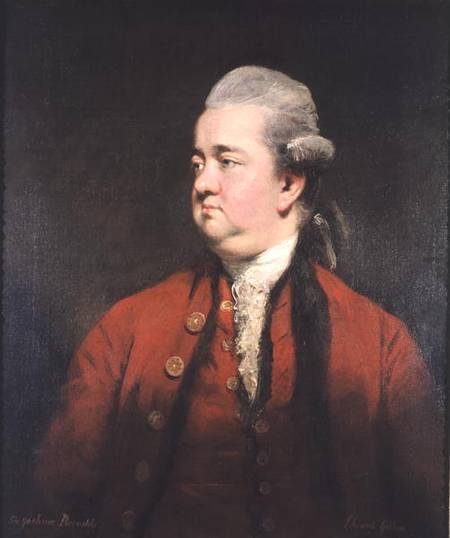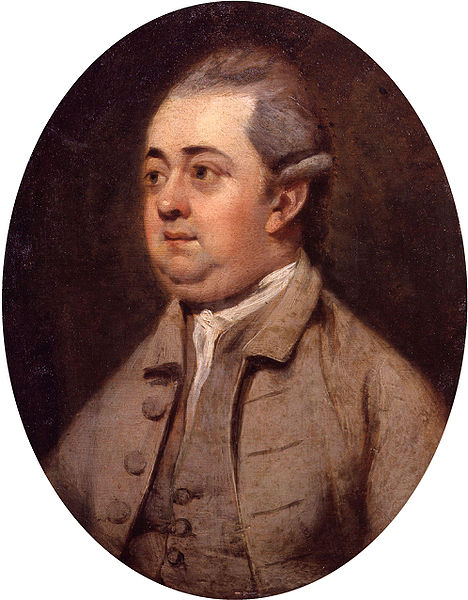<Back to Index>
- Historian Edward Gibbon, 1737
- Painter Nathaniel Dance-Holland, 1735
- General of the Mexican Revolutionary Army Miguel Gregorio Antonio Ignacio Hidalgo y Costilla y Gallaga Mondarte Villaseñor, 1753
PAGE SPONSOR


Edward Gibbon (April 27, 1737 [May 8, N.S.] – January 16, 1794) was an English historian and Member of Parliament. His most important work, The History of the Decline and Fall of the Roman Empire, was published in six volumes between 1776 and 1788. The Decline and Fall is known for the quality and irony of its prose, its use of primary sources, and its open denigration of organised religion.
Edward
Gibbon was born in 1737, the son of Edward and Judith Gibbon at Lime
Grove, in the town of Putney, Surrey.
He had six siblings: five brothers and one sister, all of whom died in
infancy. His grandfather, also named Edward, had lost all of his assets
in the South
Sea
Bubble stock
market
collapse (1720), but eventually regained much of his wealth, so that
Gibbon's father was able to inherit a substantial estate. As a
youth, his health was under constant threat. He described himself as "a
puny child, neglected by my Mother, starved by my nurse." At age nine,
Gibbon was sent to Dr. Woddeson's school at Kingston
upon
Thames, shortly after which his mother died. He then took up
residence in the Westminster School boarding
house, owned by his adored "Aunt Kitty," Catherine Porten. Soon after
she died in 1786, he remembered her as rescuing him from his mother's
disdain, and imparting "the first rudiments of knowledge, the first
exercise of reason, and a taste for books which is still the pleasure
and glory of my life." By
1751,
Gibbon's reading was already voracious and certainly pointed
toward his future pursuits: Laurence
Echard's Roman
History (1713),
William Howel(l)'s An
Institution
of General History (1680 – 85),
and
several of the 65 volumes of the acclaimed Universal History from the Earliest Account of Time (1747 – 1768). Following
a stay at Bath in 1752 to improve his health, at the age of 15 Gibbon
was sent by his father to Magdalen
College, Oxford, where he was enrolled as a gentleman-commoner. He
was ill-suited, however, to the college atmosphere and later rued his
14 months there as the "most idle and unprofitable" of his life. But
his penchant for "theological controversy" (his aunt's influence) fully
bloomed when he came under the spell of rationalist theologian Conyers
Middleton (1683 – 1750)
and
his Free Inquiry into the Miraculous Powers (1749). In that tract,
Middleton denied the validity of such powers; Gibbon promptly objected.
The product of that disagreement, with some assistance from the work of
Catholic Bishop Jacques-Bénigne
Bossuet (1627 – 1704),
and
that of the Elizabethan Jesuit Robert
Parsons (1546 – 1610),
yielded the most memorable event of his time at Oxford: his conversion
to Roman
Catholicism on June
8, 1753. He was further "corrupted" by the 'free thinking' deism of the
playwright/poet couple David
and
Lucy Mallet; and finally Gibbon's
father, already "in despair," had had enough. Within
weeks of his conversion, the youngster was removed from Oxford and sent
to live under the care and tutelage of Daniel Pavillard, Reformed
pastor of Lausanne,
Switzerland. It was here that he made one of his life's two great
friendships, that of Jacques
Georges
Deyverdun (the
French language translator of Goethe's The
Sorrows
of Young Werther); the other being John Baker Holroyd (later Lord
Sheffield). Just a year and a half later, after his father
threatened to disinherit him, on Christmas Day, 1754, he reconverted to Protestantism.
"The
articles of the Romish creed," he wrote, "disappeared like a
dream." He remained in Lausanne for five intellectually productive
years, a period that greatly enriched Gibbon's already immense aptitude
for scholarship and erudition: he read Latin literature; traveled
throughout Switzerland studying its cantons' constitutions; and
aggressively mined the works of Hugo
Grotius, Samuel
von
Pufendorf, John
Locke, Pierre
Bayle, and Blaise
Pascal.
He
also
met the one romance in his life: the pastor of Crassy's daughter,
a young woman named Suzanne
Curchod, who would later become the wife of Louis XVI's finance
minister Jacques
Necker, and the mother of Madame
de
Staël. The two developed a warm affinity; Gibbon proceeded
to propose marriage, but
ultimately wedlock was
out of the question, blocked both by his father's staunch disapproval
and Curchod's equally staunch reluctance to leave Switzerland. Gibbon
returned to England in August 1758 to face his father. There could be
no refusal of the elder's wishes. Gibbon put it this way: "After a
painful struggle I yielded to my fate: I sighed as a lover, I obeyed as
a son." He proceeded to cut off all
contact with Curchod, even as she vowed to wait for him. Their final
emotional break apparently came at Ferney,
France,
in the spring of 1764, though they did see each other at least
one more time a year later. Upon his
return to England, Gibbon published his first book, Essai sur l'Étude
de la Littérature in
1761,
which produced an initial taste of celebrity and distinguished
him, in Paris at least, as a man of letters. From 1759 to 1770, Gibbon
served on active duty and in reserve with the South Hampshire militia,
his deactivation in December 1762 coinciding with the militia's
dispersal at the end of the Seven
Years'
War. The following year he
embarked on the Grand
Tour (of
continental Europe), which included a visit to Rome.
The Memoirs vividly record Gibbon's
rapture when he finally neared "the great object of [my] pilgrimage": I can
neither forget nor express the strong emotions which agitated my mind
as I first approached and entered the eternal
[C]ity. After a sleepless night, I trod, with a lofty step, the
ruins of the Forum; each memorable spot where Romulus stood, or Tully
spoke, or Caesar fell, was at once present to my eye; and several days
of intoxication were lost or enjoyed before I could descend to a cool
and minute investigation. And it
was here that Gibbon first conceived the idea of composing a history of
the city, later extended to the entire empire,
a moment known to history as the "Capitoline vision": It was
at Rome, on the [fifteenth] of October[,] 1764, as I sat musing amidst
the ruins of the Capitol,
while
the bare[-]footed fryars were singing [V]espers in the temple of Jupiter,
that
the idea of writing the decline and fall of the [C]ity first
started to my mind.
His
father died in 1770, and after tending to the estate, which was by no
means in good condition, there remained quite enough for Gibbon to
settle fashionably in London at 7 Bentinck Street, independent of
financial concerns. By February 1773 he was writing in earnest, but not
without the occasional self-imposed distraction. He took to London
society quite easily, joined the better social clubs, including Dr.
Johnson's Literary
Club, and looked in from time to time on his friend Holroyd in
Sussex. He succeeded Oliver
Goldsmith at the
Royal Academy as 'professor in ancient history' (honorary but
prestigious). In late 1774, he was initiated a freemason of the Premier
Grand
Lodge of England. And, perhaps least
productively in that same year, he was returned to the House of Commons
for Liskeard, Cornwall, through the intervention of his relative and patron, Edward
Eliot. He became the archetypal back-bencher, benignly "mute" and
"indifferent," his support of the Whig ministry routinely
automatic. Gibbon's indolence in that position, perhaps fully
intentional, subtracted little from the progress of his writing. After
several rewrites, with Gibbon "often tempted to throw away the labours
of seven years," the first volume of what would become his life's major
achievement, The
History
of the Decline and Fall of the Roman Empire, was
published on February 17, 1776. Through 1777, the reading public
eagerly consumed three editions for which Gibbon was rewarded
handsomely: two-thirds of the profits amounting to approx. £1000. Biographer Leslie
Stephen wrote that
thereafter, "His fame was as rapid as it has been lasting." And as
regards this first volume, "Some warm praise from David
Hume overpaid the labour of ten years." Volumes
II and III appeared on March 1, 1781, eventually rising "to a level
with the previous volume in general esteem." Volume IV was finished in
June 1784; the final two were
completed during a second Lausanne sojourn (September 1783 to August
1787) where Gibbon reunited with his friend Deyverdun in leisurely
comfort. By early 1787, he was "straining for the goal;" and with great
relief the project was finished in June. From the Memoirs: It was
on the ...night of the 27th of June, 1787, between the hours of eleven
and twelve, that I wrote the last lines of the last page in a
summer-house in my garden. ... I will not dissemble the first emotions
of joy on the recovery of my freedom; and perhaps the establishment of
my fame. But my pride was soon humbled, and a sober melancholy was
spread over my mind by the idea that I had taken my everlasting leave
of an old and agreeable friend. Volumes
IV, V, and VI finally reached the press in May 1788, publication having
been delayed since March to coincide with a dinner party celebrating
Gibbon's 51st birthday (the 8th). Mounting a bandwagon of
praise for the later volumes were such contemporary luminaries as Adam
Smith, William
Robertson, Adam
Ferguson, Lord
Camden, and Horace
Walpole. Smith remarked that Gibbon's triumph had positioned him
"at the very head of [Europe's] literary tribe." The years
following Gibbon's completion of The
History were filled
largely with sorrow and increasing physical discomfort. He had returned
to London in late 1787 to oversee the publication process alongside Lord
Sheffield,
John Baker-Holroyd. With that accomplished, in 1789 it
was back to Lausanne only to learn of and be "deeply affected" by the
death of Deyverdun, who had willed Gibbon his home, La Grotte. He
resided there with little commotion, took in the local society,
received a visit from Sheffield in 1791, and "shared the common
abhorrence" of the French Revolution. In 1793, word came of Lady
Sheffield's death; Gibbon immediately quit Lausanne and set sail to
comfort a grieving but composed Sheffield. His health began to fail
critically in December, and at the turn of the new year, he was on his
last legs. Gibbon is
believed to have suffered from hydrocele
testis, a condition which causes the scrotum to swell with fluid in
a compartment overlying either testicle. In an age when
close-fitting clothes were fashionable, his condition led to a chronic
and disfiguring inflammation that left Gibbon a lonely figure. As his condition worsened,
he underwent numerous procedures to alleviate the condition, but with
no enduring success. In early January, the last of a series of three
operations caused an unremitting peritonitis to set in and spread, from
which he died. The "English giant of the Enlightenment" finally succumbed at 12:45
pm, January 16, 1794 at age 56. He was buried in the Sheffield family
graveyard at the parish church in Fletching, Sussex.